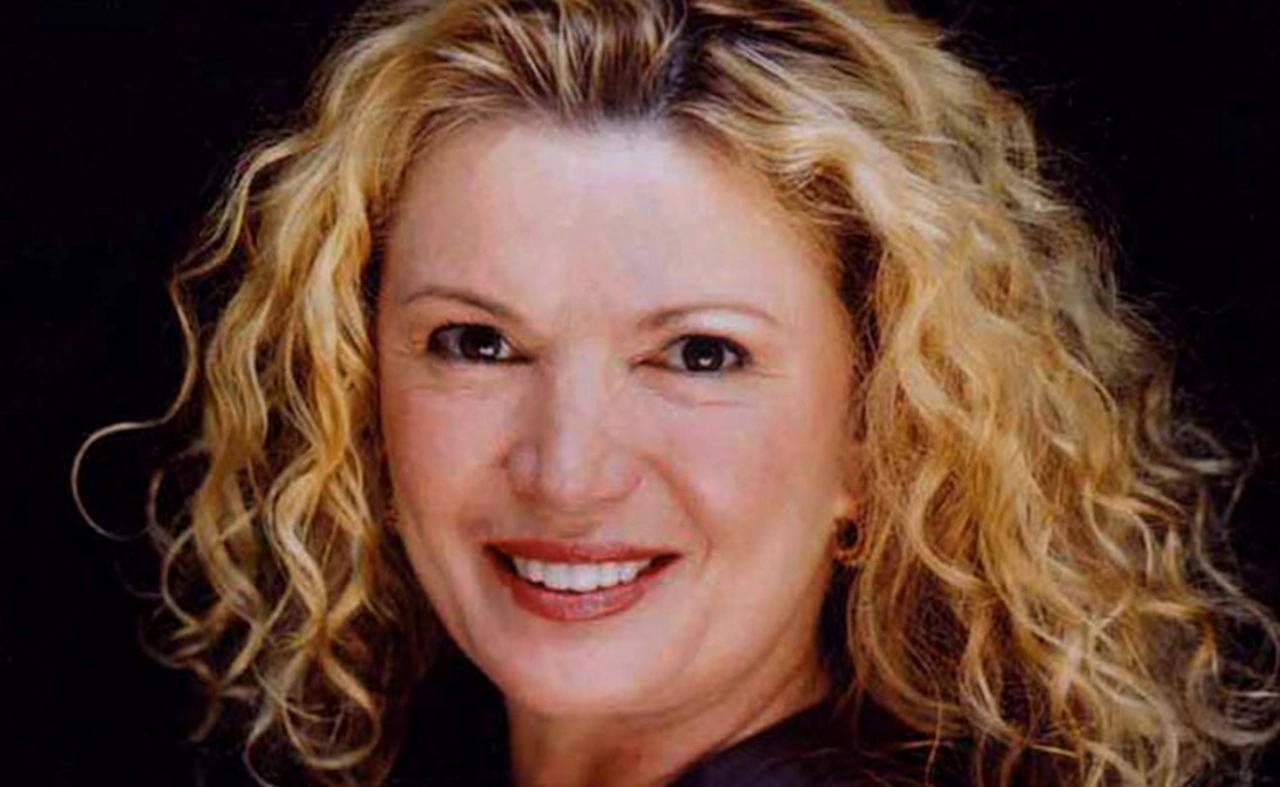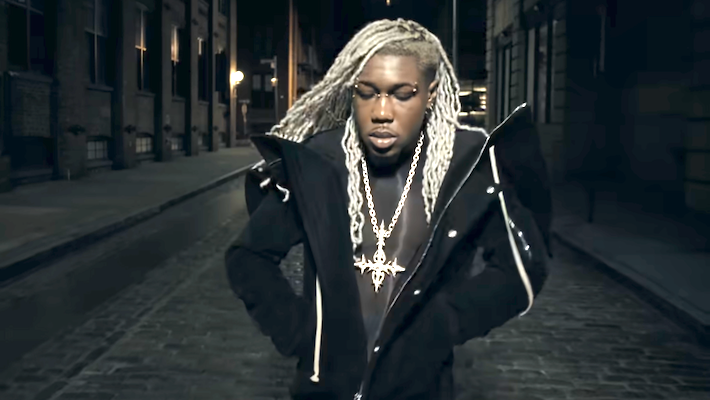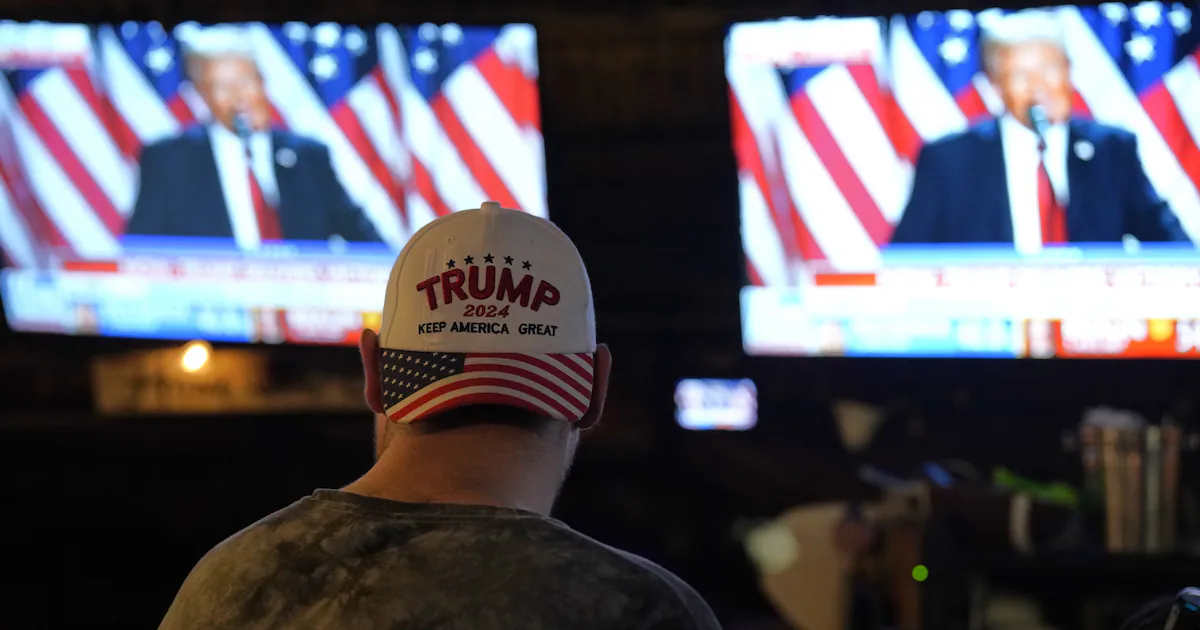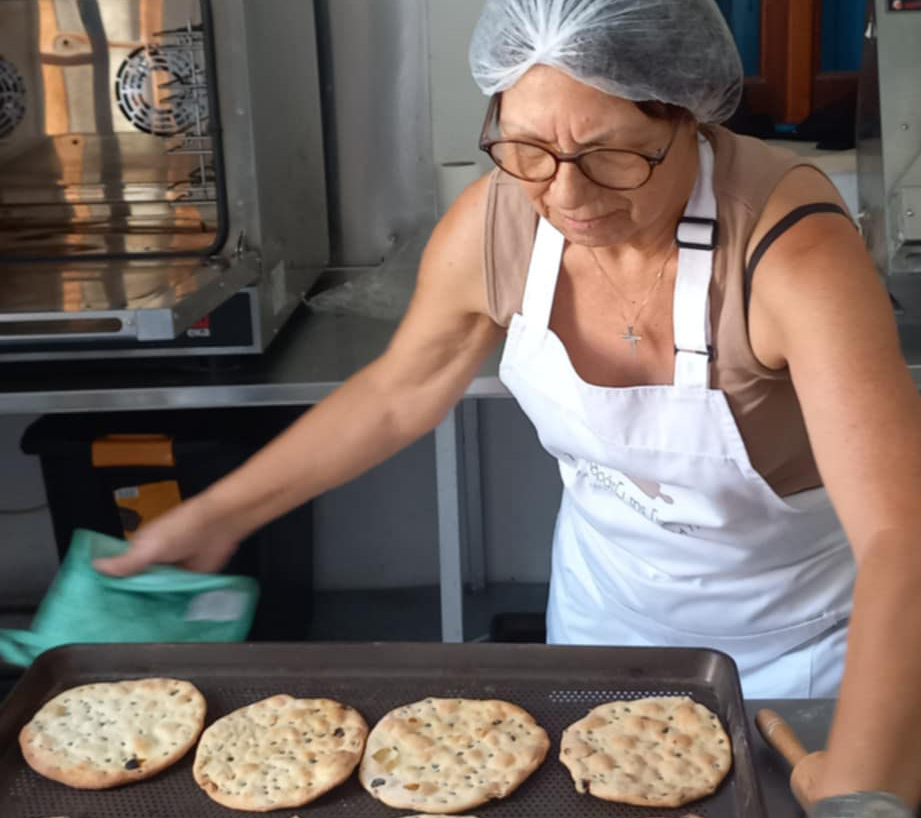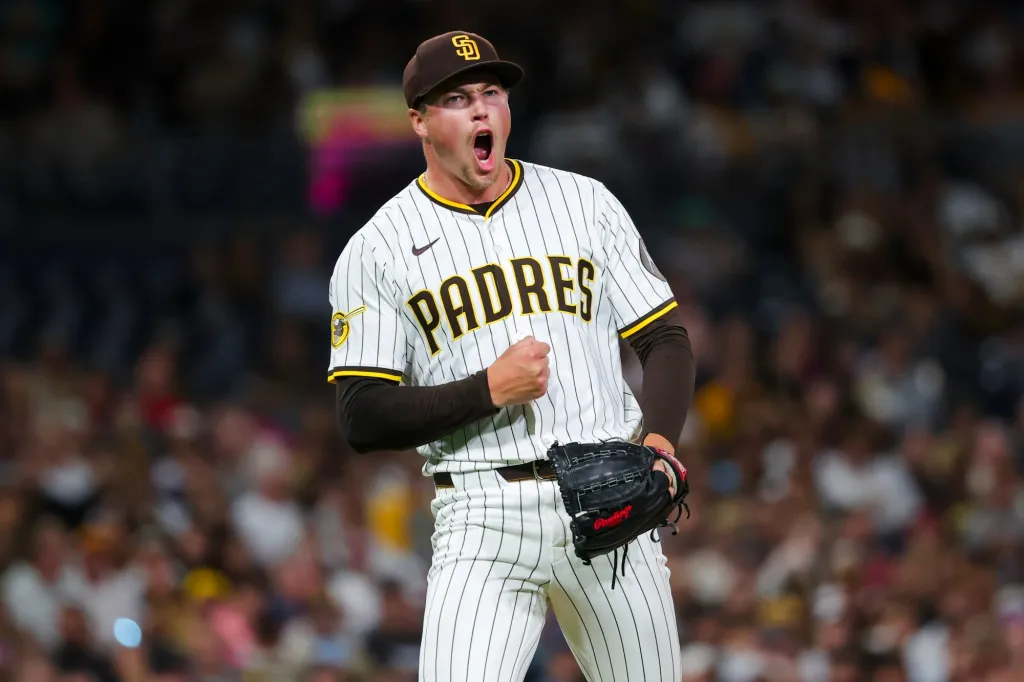
In a blockbuster deal that shocked many at the deadline, the Athletics traded reliever Mason Miller and starter JP Sears to the Padres in exchange for top prospect Leo De Vries and a package of pitching prospects. Miller, 27, was a third-round pick by Oakland in the 2021 MLB Draft. He made his big-league debut in 2023 and earned a spot in the All-Star Game the following year. Known for his electric velocity, Miller’s fastest recorded pitch touched 104.1 mph and he has thrown more than twice as many pitches at 101 mph or higher than any other pitcher in the league.
A native of Pittsburgh and a lifelong Steelers fan, Miller’s life took a dramatic turn in 2018 when he was diagnosed with Type 1 diabetes, a challenge that shaped him personally and professionally. Miller is under team control through the 2029 season.
The Union-Tribune talked to Miller about his diagnosis, finding success as a pitcher and moving from the rotation to the bullpen. This interview has been edited for length and clarity:
You were homeschooled growing up, but still played baseball with local teams. How did baseball fit into your life during that time?
A: Baseball has been a huge part of my life throughout the whole thing, really. There’s portions of it where the dream of playing in the big leagues, like I am now, may not have been as clear as it is today. But yes, I did my coursework online in high school and took some college courses through a dual-enrollment (program). Just to try and get ahead of it a little bit, make college a little lighter. It was good. Baseball has always been probably my favorite activity. Definitely my favorite sport. A lot of my life revolved around baseball since I was really young.
You wanted to be the first in your family to graduate from college, right?
A: I was the first in my immediate family, yeah. That was something that was important to me. I was fortunate enough to be able to get two degrees while playing baseball and eventually — partially thanks to COVID and getting an extra year (of eligibility) — I was able to transfer to Gardner-Webb University and put myself on a little bit bigger stage and get myself recognized by some scouts, and get into pro ball, and find myself here.
You had some twists and turns along the way. You began your college career at Waynesburg University, where you did, I would say, OK.
A: OK is generous. I was pretty bad. I think I had a 7.00 ERA my first two years.
You did, actually. So at this point, it’s fair to say you’re not really dreaming about a career in the major leagues, correct?
A: Correct. Leaving high school, I went Division III so I could play my freshman year. That was what was important to me. It wasn’t really where I was playing, it was just that I was playing, and Waynesburg gave me that opportunity despite my struggles. I was grateful for that.
Back then, your fastball hit high 80s, low 90s as far as velocity?
A: Coming out of high school, yeah, I think I touched 90 (mph). And then my sophomore year, my velocity took a dip and I was pitching about 83 to 84 (mph).
What did you make of that at the time?
A: I had lost weight. We didn’t really know why at that point, but that’s pretty much what I was chalking it up to. We also didn’t have a radar gun that we used every day, so it wasn’t like I watched (my velocity) fall. It was just kind of like, ‘Yeah, it’s a little slower.’ And then some days you end up playing on a field that has radar and you’re like, ‘Oh, man. Well, maybe today was just a bad day.’ You make excuses.
Then you get a finance internship at a local hospital where, you take the mandatory drug test for employment. And you fail it?
A: Not a fail. Not quite a fail. They were suspicious that I was trying to fudge it around a little bit, so they tested it further. But yeah, didn’t fail the drug test. They just tested it further than they normally would have, and that’s where they discovered my blood sugar was really elevated and they recommended I go to the emergency room. And that’s where I got diagnosed with Type 1 diabetes.
Wow. If you hadn’t done that drug test, who knows where your health might have gone, right?
A: Yeah, all the charts they showed me in the hospital of blood sugar levels, mine was far and above where they were. So it could have been weeks, it could have been longer, I don’t know. But my life was at risk for sure. I was grateful that happened when it did.
What do you remember thinking when you first got diagnosed?
A: I had heard of diabetes. I’d never really heard of the differentiation between Type 1 and Type 2. I always kind of attributed it to diet or lack of physical activity or genetics. No history of diabetes in my family. I was 20 years old, thin, pretty active, so I was confused. But I quickly learned that it’s an autoimmune disorder and that nothing I did resulted in it happening. Just kind of my body attacking itself and not producing insulin like everyone else. So, kind of a weird thing to wrap your head around. But I felt fortunate that I was a little bit older. A lot of kids get diagnosed at young ages and a lot of times they can’t even understand what’s going on. I was 20 years old and self-aware enough to realize what was going on, and also realized what I had to do to continue living and continue doing what I wanted to do. I felt a little bit of encouragement from that. I finally had a grasp on what was going on.
What were you experiencing pre-diagnosis, and how did that change post-diagnosis?
A: I lost some weight, about 25 pounds or so over the course of a couple months. So it wasn’t overnight. But I was pretty thin already, and then really thin. I was 6’5 and about 160 pounds, so skin and bones, if you will. I was really thirsty and in turn, was urinating a lot, and that was like my body’s way of trying to regulate it on its own. Obviously, I couldn’t keep up. Those were the biggest symptoms. Just a really unquenchable thirst. I’d mix up a two-liter thing of Gatorade and just drink it straight out of the pitcher. It was bad. … It’s like that feeling on a hot summer day and you’re outside and you get an ice-cold drink and you just can’t get enough of it. Just unquenchable.
(Post-diagnosis), it’s back to normal, I guess. I didn’t feel like I lost normal, because it happened slowly. But putting the weight back on, even just from being able to retain the fluids I was drinking. And then a byproduct of getting rid of all the excess sugar that the body could on its own, it was also flushing all the nutrients I was getting from food, too. So just being able to consume those nutrients and benefit from them again was really, really nice. I just felt healthy. I’d been trying to put on weight and now I finally was, so it was kind of a “wind at your back” feeling.
Then did you pick up a baseball and realize, ‘Hey, I’ve got a little more strength here?’
A: It was in April that I was diagnosed, and the season was ending at the end of April, so I think I pitched in one more game before the end of the season. Kind of a, ‘Yeah, I can still play baseball. I don’t really know what this is going to be like.’ I think I did fine. I don’t really remember how it went. But then that summer I worked out and threw. Didn’t really have any idea how it was going to translate to the field, but I figured it would help. Then I had a really good fall my junior year, and an awesome season my junior year. So it kind of just came to a head. Like I said, we didn’t have the analytics or the radar guns or things like that to really track the progress along with it. But post-diagnosis, my first full season was incredible.
Did you touch 100 mph that season?
A: No. I don’t know if I touched 100 until Gardner-Webb, or even post-draft.
What stands out to me about your journey is that you were on this clear path toward a finance career, and then within a year or two, you’re drafted by the Athletics and on your way to the big leagues. How did you and your family process that at the time?
A: Yeah, it happened really fast. And my family — they’re big fans of me, and me playing baseball, but at that time, I don’t know how wide their horizon was on their general baseball (knowledge) of how the draft worked or what the likelihood of me playing in the big leagues was. They knew it was slim, I think. But I know my parents were happy that when I went to Gardner-Webb, I was able to get my master’s (degree) also. I turned down a great (finance) job that I would have had coming into 2020. It was with the health network that I did the internship with. So that was cool to have. I had some comfort going into COVID that I had accepted a job, and then once I got the extra year of eligibility, I was kind of a little torn on what to do. But I didn’t want to have any regrets. So I took the chance to go play and that was kind of my ‘I’m going all in on baseball’ (moment) even if it didn’t feel like that to everybody else. Because I kind of rationalized it like, ‘Oh, I could just get my master’s and I can get that job again in a year after I finish if (baseball) doesn’t work out.’ But that moment that I went back for my fifth year of school was kind of, ‘Baseball is what I want to strive to do.’
What did it feel like to get drafted?
A: That kind of felt like a huge relief for me. Because I felt like I was going all in on baseball and it felt a little risky. A lot of things could have happened. I had a good season. Just all that work from the past season being realized in that moment, seeing your name on the TV, and getting the call and everything. And then you have a couple days where it kind of just settles in and then it’s off to Arizona, and off you go. You’re playing baseball again.
What do you contend with daily in terms of managing any complications from diabetes?
A: Fortunately, I had a great training staff with the A’s that made it super easy for me. The staff here has been awesome as well. It’s comforting knowing that you have those safety nets around, but fortunately, I’ve never had to use them. I take really good care of myself and I pride myself on that. And the technology that is out there these days is awesome. I wear a Dexcom (continuous glucose monitor) that keeps (track of) my blood sugar and I get updates on it every five minutes. So really, unless you’re asleep at the wheel, it’s pretty hard to not know what’s going on.
Raising awareness for juvenile diabetes is very important to you. What drives that, and how does it show up for you?
A: I think I’m in a unique position as it is, just being a big-league baseball player. I got my dream as a little kid realized and that’s awesome. So I have a responsibility to kids that come to games, I believe, to have the same impact and grow that love of the game and grow that admiration for what we do. That’s the stage we’ve been put on. It’s up to each individual how involved they want to be and things like that. And it is a long year, so it’s hard to do it every day. But from a standpoint of diabetes, I know that there’s kids that are fans. I remember even at 20 years old, I looked up athletes that had Type 1 diabetes while I was in the hospital, days after I was diagnosed. So I know a lot of kids do that too, and I know that my name is the name that pops up now. I have a lot of kids or their families reach out to me, sometimes just thanking me for what I do, but also just to have a chance to meet me or whatever, and I’m able to bring them down on the field before a game, talk to them, meet them, give them a cool experience. You know, me aside, it’s cool for me to meet them. I tell them it’s as surreal and as rewarding for me to meet them as it is for them to meet me. I don’t think any of them believe me but yeah, it’s just a cool experience in and of itself, being a kid and getting to come down on a big league field and watch guys like Manny (Machado) and (Fernando Tatis Jr.) and all these guys that are stars that they watch on TV all the time.
After starting your whole career, the A’s moved you to the bullpen in 2024. Were you hesitant about the switch and did you push back at all?
A: I wouldn’t say I was excited about it necessarily, but I think for health reasons — which is why we did it — it made sense. I hadn’t shown I’d been able to stay healthy as a starter in 2022 in the minor leagues and in 2023 when I made my debut. So yeah, I didn’t necessarily love the idea because it’s something that I had done for so long, but I was just grateful to have an opportunity in the big leagues, so I wanted to make the most of that. Fortunately, it’s worked out really well.
When did you touch 100-plus on the radar gun, and did it surprise you to do that?
A: Yeah. I mean, I knew I throw hard, but I’d watch other guys throw and sometimes it was 95 (mph) and I’m like, ‘Man, that’s pretty fast.’ I remember hitting and anything over 85 (mph), I could barely see. So I am kind of surprised myself sometimes too. But I try not to focus so much on the velocity and I just try to focus on executing and staying within myself, as opposed to trying to do too much.
What do you think are misconceptions about high-velocity pitchers? A lot of people assume that if you throw that hard, getting outs is automatic.
A: You do get away with some things that other guys don’t get away with. Missed locations, mistakes, things like that. But at the end of the day, if you’re going to be successful in this league, you have to have more than one pitch. You have to be able to be more than just a one-trick pony. Be able to locate, be able to change speeds, things like that.
Evidenced by the immaculate inning by you with all sliders, which was fun to watch. Do you sneak a peek at the velo board sometimes?
A: Yeah, I’m guilty for sure.
You spent your entire career with the Athletics before coming here. Were you surprised to be traded, and how difficult is a midseason trade?
A: I was a little surprised, yeah. I’m a younger player. I had a lot of controllable time left. But being from the As, I kind of knew it was possible. But (a) trade mid-season is not the easiest thing to do. You start worrying about things away from the park. Playing baseball, that’s the easy part; it’s never easy, but the first pitch happens and then it’s baseball. It’s like, ‘Well, hey, I know what I’m doing here. I feel comfortable doing this.’ But moving your family, finding a new place to live, moving out of your old place. It’s just very hectic. And baseball doesn’t stop for that.
What do you do when you are not at the ballpark?
A: Golf’s a big hobby of mine. Always trying to get a little better. It’s just relaxing. I enjoy it a lot, and it’s a good time with some of the guys or buddies back home. But besides that, my wife and I like to spend a lot of time together away from the field since this lifestyle and this job, if you will, is very time-demanding. You spend a lot more time with your teammates sometimes than your family, so just appreciating those moments that you get at home and being intentional with that.
Favorite sugary snack?
